The Nagahama Plum Tree Bonsai Exhibition (Nagahama Bonbai-Ten) started in
1952 after Shichizo Takayama (see below) gave 40 bonsai trees to Nagahama-city. It has now become the number one
bonsai plum tree exhibition in Japan in terms of both history and scale. It is a much loved springtime tradition
in the Kansai region. Bonbai (aka bonmei
or bon-ume) is a Japanese apricot or plum tree in bonsai style. Scientifically labeled as
Prunus mume, these are actually native to
South-Central China and Laos in woods and rocky hills. The Japanese flowering apricot is an important
tree in Chinese culture and has been cultivated for over 1500 years. The five petals of the Chinese plum
or wu mei
flower are said to represent five blessings that include wealth, health, love of virtue, old age, and natural
death. Although they did not originate in Japan, they have been grown extensively here for a thousand
years and number up to 300 ume cultivars. They are among the first blooming trees in the winter
-- with white, red or pink flowers -- hence this show is designed to capture their unique seasonal beauty.
The bonbai in Nagahama are lined up in a pure Japanese-style tatami-mat
room in historic Keiunkan, a traditionally
styled wooden building set in delightful gardens that can be beautifully dusted with snow in the winter.
This is located in the center of Nagahama city near
JR Nagahama Station (2-5, Minatocho, Nagahama-shi, Shiga, 526-0067). This is on the northeast side of
Lake Biwa, about 96 km/almost 60 miles to the northeast
of Kyoto. The building and gardens were built in 1887 as a guesthouse for
Emperor Meiji near what was the 1601
Nagahama Castle. The guesthouse was named by
Japan's first Prime Minister, Hirofumi Ito.
(The currently extant castle was built in 1981 as a museum of history.)
From among the 300 trees approximately available, 90 are on display
at any one time. These are replaced sequentially according to how they bloom during the period, in
accordance with their flowering. Thus, you could attend the show every year and never see the same type
of exhibition. You are allowed and even encouraged to take photos, and to take as long as you want to
wander through the show, returning again to your favourites. There are even Special Night Illumination tours
available in February, with the gardens outside the guesthouse lit up for after-hours strolling on Saturdays,
Sundays and holidays, and some Tuesdays, Thursdays, and Fridays. The Nagahama
Bonsai Exhibition of Ume Trees with Blossoms is characterized by having both big and very old trees, with larger
specimens reaching >3 meters/about 10 feet in height while older ones reach ages of 80 to 400 years.
The often-seen specimen named "Furo" (which means "Eternal Youth") is probably the oldest. (What is its history,
where was it obviously field grown for the first part of its long life, when was it first potted, does it spend the
rest of the year on the Keiunkan grounds, what does it look like fully leafed out?) Many of the larger
trees have a bamboo support because the plants are top-heavy with much deadwood along the trunk's length.
There are also displayed a few plum bonsai even down to shohin size, less than 20 cm or 8" tall.
The Bonbai-ten admission price is now ¥800 for adults (currently
about 5.17 USD or 4.92 Euro) and ¥400 for elementary and junior high school students.
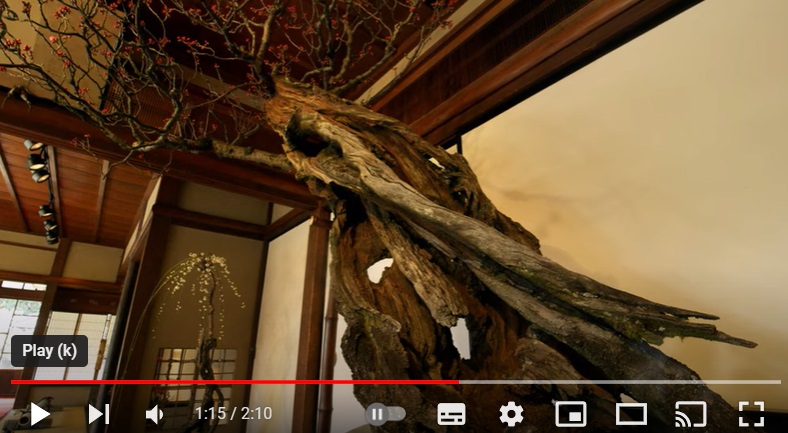
Red blossoming "Furo" ("Furou") 400 yr-old Prunus mume
(screenshot at 1:15 from Nagahama Bonsai Exhibition of Ume Trees with
Blossoms [Nagahama Tourism Association] (2022))
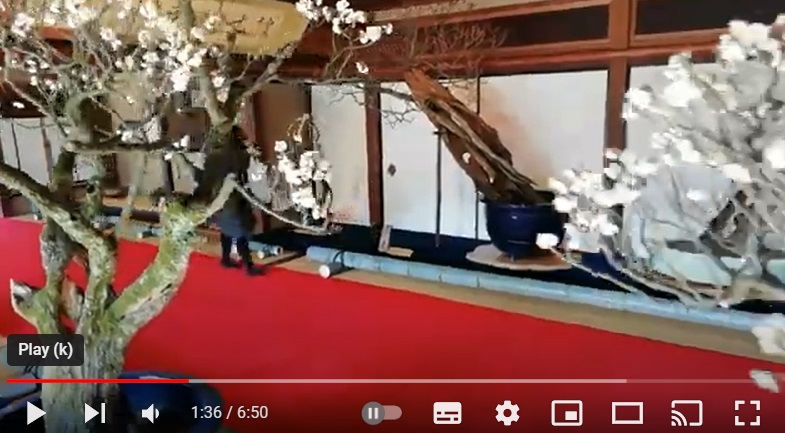
"Furo" with Other Flowering Plums (Prunus mume)
(screenshot at 1:36 from Beauty of Shiga, Japan / Bonbai Plum Tree Exhibition
[Japan_go.biwako] (2021))
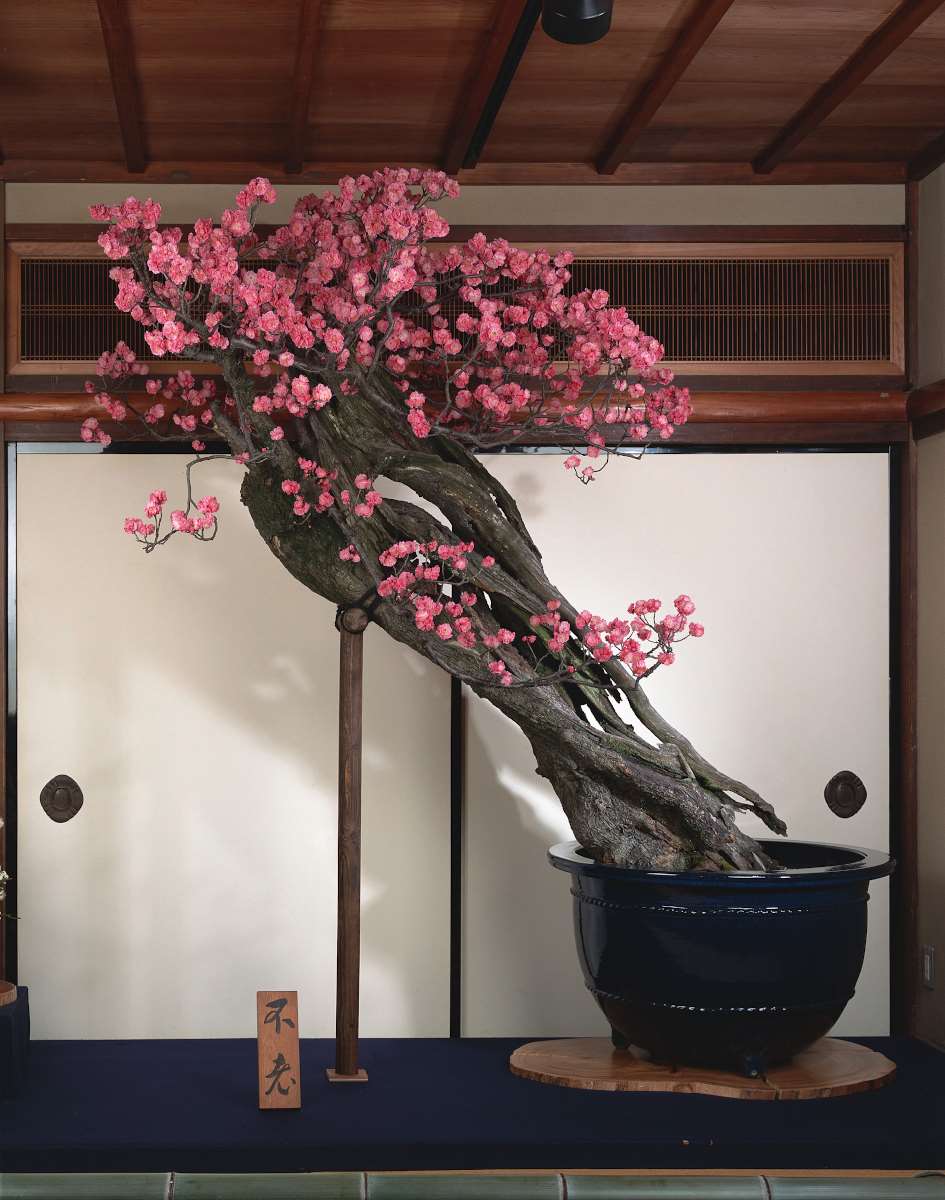
"Furo" in Full Bloom (Prunus mume),
described as "Apricot Scarlet Hakama Anzusho Hinohakama" variety,
Height 240cm / 7' 10.5", Diameter 60cm / 1' 11.6"
(from https://bonbai.jp/catalog/2023/11/13694/)
This event includes other old ume trees such as "Shoryubai" (which means "Rising Dragon"), about
250 years old with single white flowers, 190cm / 6' 2.8" high and 100cm / 3' 3.3" around; and "Sazareiwa" (or "Sazareishi", which
means "Limestone Breccia"), about 350 years old with double rose-pink flowers,
280cm / 9' 2.2" high and 160cm / 5' 3" around.
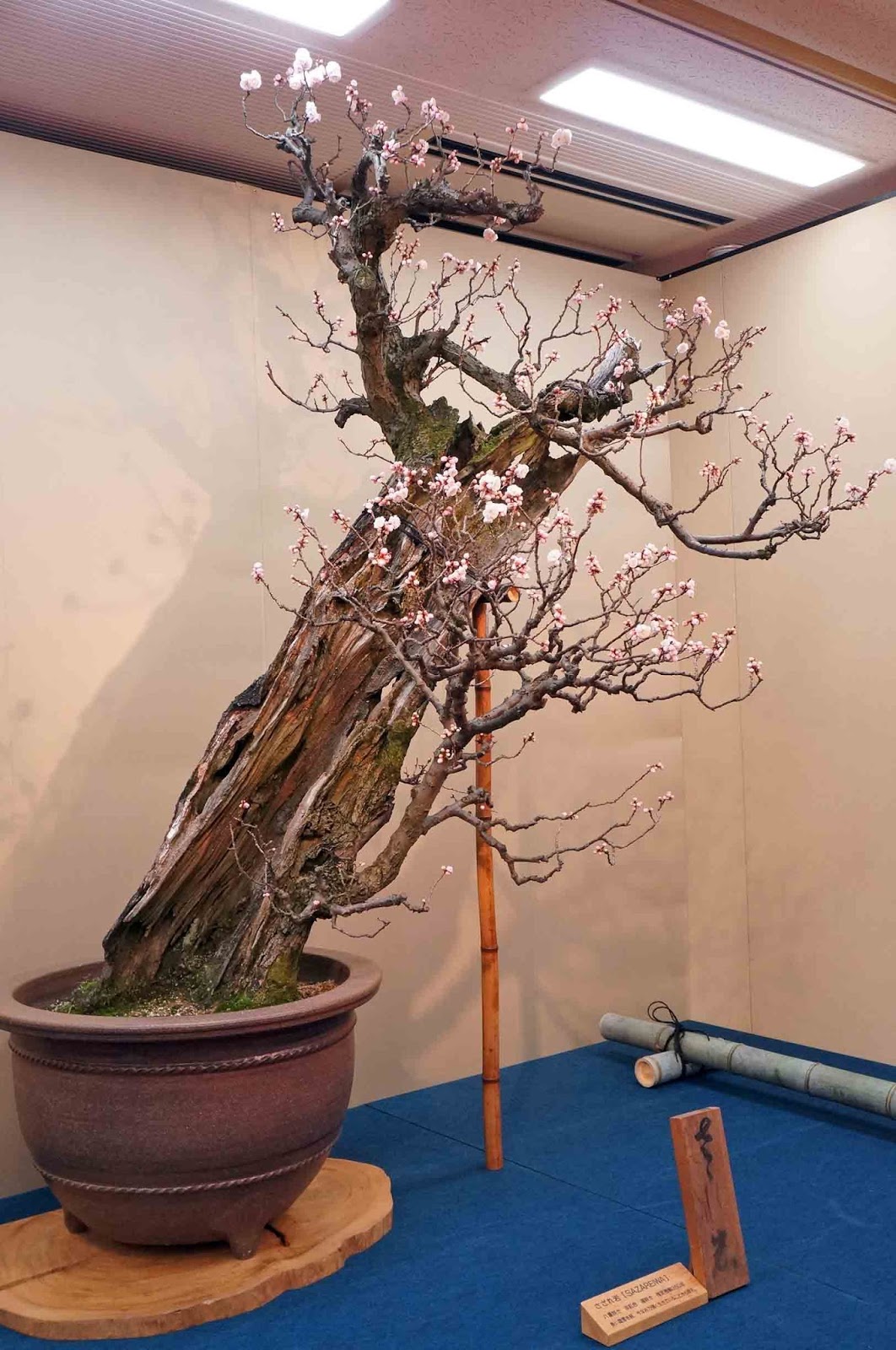
"Sazareiwa" 350 yr-old Prunus mume
(from The 65th Bonsai Exhibition of Ume trees in
Nagahama, Nagahama Bonbai-Ten)
There are about 2,000 plum trees (including the ones planted on the ground)
in Nagahama of about 70 cultivars. In the city there are four places where plum bonsai trees have been
maintained. Because the plum bonsai trees are natural things, they can be infected by various tree diseases.
Once they are infected, they cannot be placed in one place, so this is why they have more than one place to take
care of plum bonsai trees. Bonsai experts take care of these container specimens. They also collect old ume trees
growing in the ground, pot them up and train them into bonsai for 10 to 20 years. After training for years, ume trees can
make their debut as bonsai at this event every year.
The website http://bonbai.jp/
dates to at least early 2018,
with an English extension since
at least early 2020. The
Nagahama Mayor presents an award each year at the show. (See about half-way down this page for
successive photo contest results
by year.) We are not aware of any type of catalog which is published for this event, unlike at most
other exhibitions, nor have we come across reference to any vendor area other than various small plum bonsai
with buds being sold at the giftshop near the exit.
| YEAR |
DATE |
NUMBER |
NOTES |
| 1976 |
Jan - Mar |
25th Exhibition |
|
| 1977 |
Jan - Mar |
26th Exhibition |
|
| 1978 |
Jan - Mar |
27th Exhibition |
|
| 1979 |
Jan - Mar |
28th Exhibition |
|
| 1980 |
Jan - Mar |
29th Exhibition |
|
| 1981 |
Jan - Mar |
30th Exhibition |
|
| 1982 |
Jan - Mar |
31st Exhibition |
|
| 1983 |
Jan - Mar |
32nd Exhibition |
|
| 1984 |
Jan - Mar |
33rd Exhibition |
|
| 1985 |
Jan - Mar |
34th Exhibition |
|
| 1986 |
Jan - Mar |
35th Exhibition |
|
| 1987 |
Jan - Mar |
36th Exhibition |
|
| 1988 |
Jan - Mar |
37th Exhibition |
|
| 1989 |
Jan - Mar |
38th Exhibition |
(This year, Shichizo Takayama's younger sister, Kotome, and her husband,
Shigesa Takayama, donated about 50 Bon plum trees to Nagahama City.) |
| 1990 |
Jan - Mar |
39th Exhibition |
|
| 1991 |
Jan - Mar |
40th Exhibition |
|
| 1992 |
Jan - Mar |
41st Exhibition |
|
| 1993 |
Jan - Mar |
42nd Exhibition |
|
| 1994 |
Jan - Mar |
43rd Exhibition |
|
| 1995 |
Jan - Mar |
44th Exhibition |
|
| 1996 |
Jan - Mar |
45th Exhibition |
|
| 1997 |
Jan - Mar |
46th Exhibition |
|
| 1998 |
Jan - Mar |
47th Exhibition |
|
| 1999 |
Jan - Mar |
48th Exhibition |
|
| 2000 |
Jan - Mar |
49th Exhibition |
|
| 2001 |
Jan - Mar |
50th Exhibition |
|
| 2002 |
Jan - Mar |
51st Exhibition |
|
| 2003 |
Jan - Mar |
52nd Exhibition |
|
| 2004 |
Jan - Mar |
53rd Exhibition |
|
| 2005 |
Jan - Mar |
54th Exhibition |
|
| 2006 |
Jan - Mar |
55th Exhibition |
|
| 2007 |
Jan - Mar |
56th Exhibition |
(This year, Shigesa Takayama's eldest son, Shigehiko, donated 54 pots of Bon
plum trees to Nagahama City.) |
| 2008 |
Jan - Mar |
57th Exhibition |
|
| 2009 |
Jan - Mar |
58th Exhibition |
|
| 2010 |
Jan - Mar |
59th Exhibition |
|
| 2011 |
Jan 20 - Mar 10 |
60th Exhibition |
Admission was ¥500 for adults, and ¥200 for children 15 and under. |
| 2012 |
Jan - Mar |
61st Exhibition |
|
| 2013 |
Jan - Mar |
62nd Exhibition |
Since at least this year the Nagahama Mayor Award has been given. |
| 2014 |
Jan - Mar |
63rd Exhibition |
|
| 2015 |
January - March |
64th Exhibition |
Admission was ¥500 for adults, and ¥200 for children 15 and under. |
| 2016 |
Jan 9 - Mar 13 |
65th Exhibition |
|
| 2017 |
Jan 7 - Mar 12 |
66th Exhibition |
|
| 2018 |
Jan 10 - Mar 11 |
67th Exhibition |
Admission was ¥500 for adults, and ¥200 for children 15 and under. |
| 2019 |
Jan 10 - Mar 10 |
68th Exhibition |
|
| 2020 |
Jan 10 - Mar 10 |
69th Exhibition |
|
| 2021 |
Jan 9 - Mar 10 |
70th Exhibition |
Admission was ¥800 for adults, and ¥400 for elementary and junior high school students.
Kyoto University of Art and Design team was led by paper-cutting artist Tetsuhei Hayakawa to create a
'Bonsai no Mori' papercut habitat, where wildlife could be seen coexisting alongside bonsai trees.
(This would be continued through at least 2024.) |
| 2022 |
Jan 9 - Mar 10 |
71st Exhibition |
|
| 2023 |
Jan 8 - Mar 12 |
72nd Exhibition |
|
| 2024 |
Jan 10 - Mar 10 |
73rd Exhibition |
|
| 2025 |
Jan 10 - Mar 10 |
74th Exhibition |
|
NOTES:
"Nagahama Plum Tree Bonsai Exhibition," Biwako
Visitors Bureau ;
"Nagahama: Do :
Nagahama Bonbai Exhibition," Wikitravel.org, 21 Jul 2011 edition, accessed 03/12/2024 ;
"The 65th Bonsai
Exhibition of Ume trees in Nagahama, Nagahama Bonbai-Ten" by Yukimono, Jan 25, 2016 ;
"Bonsai (Bonbai) bloom again in Nagahama, Shiga"
by Toni Broome, Published: August 6, 2014 - Last updated: August 8, 2022 ;
"All About Japanese Plums," Minneopa Orchards,
Published: January 2, 2021 - Last updated: November 8, 2023, which states that "Currently, over 800 varieties
exist." ;
"Meet some of Japan's oldest bonsai trees at this exhibition in
Shiga Prefecture," grape, Published: 2021-01-11 - Last Updated: 2021-01-12 ;
"Plum Bonsai Exhibition
@ Nagahama City," https://mikepon.blogspot.com/, February 6, 2024 ;
"Nagahama
Bonbai Exhibition," Four Seasons in Japan, February 2013, accessed 11/21/2024 ;
"History of Bonbai in Nagahama, https://bonbai.jp,
translated via imTranslator
March 14, 2024 and edited for continuity:
For generations, the Shichizo family had owned forests and fields
in an area northeast of Nagahama. Born in 1880, Shichizo Takayama was a farmer who was enthusiastic
about starting new businesses, and the same was true for his hobbies -- including the unique one of growing
large plums in pots. At that time, plum trees were always planted in the mountains and fields.
This is because pickled plums were a preserved food essential for working outside the home. Every
year, Shichizo went into the forests and dug up an old plum tree with good branches, carried it in a cart
or mokko, and took it home. He planted them in large pots and looked after them with great care.
In spring, Shichizo enjoyed the dozens of potted Bonbai flowers he had
grown by lining them up on both sides of the entrance to his house. The work was said to be extensive
and required the employment of many people. As the village's best farmer, Shichizo employed many people
from as far away as Gifu, about 64 km/40 miles northeast of Nagahama. When the flowers were in full
bloom, many people came to view them. It can be said that it was an elegant masterpiece. Before
the war, he served as the village mayor of Kamikusano Village, and after the war, he served as a member of
the Asai Town assembly.
After the war, Shichizo in 1949 (1951?) donated 40 pots of Bon plums that he had
grown over nearly 40 years to Nagahama City. This was in response to the request of Tajuro Teramoto,
the mayor of Nagahama at the time, and the fact that he donated all the bowls also shows Shichizo's noble
character. In the early spring of 1952, three years after receiving the donation, a Bon plum exhibition
was started at Keiunkan. The attractive event, befitting the area's spring, delighted many tourism
officials. However, plums are living things. In addition to watering and fertilizing, daily care
such as pruning and repotting is essential. Even after making the donation to Nagahama City, Shichizo
often stayed in Nagahama and provided guidance on growing Bonbai trees.
Shichizo also grew Bonbai at the home of his younger sister, Kotome, who
was married to Shigesa Takayama. Mr. and Mrs. Shigesa also grew Bon plums for many years, and in 1989
they donated about 50 pots of Bon plums to Nagahama City. In his later years, Shichizo moved to Kyoto,
where his eldest son lived, and died in Kyoto in 1962. He was eighty-two years old when he passed away.
Seven years later, the villagers created a small park near his birthplace to commemorate Shichizo. More
recently, in 2007, Shigesa's eldest son, Shigehiko, donated 54 pots of Bon plum trees to Nagahama City.
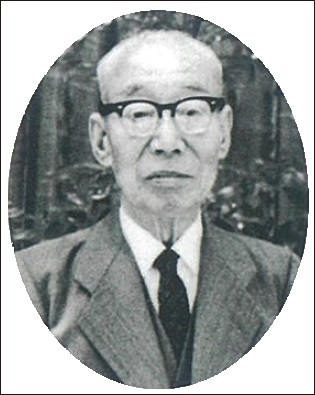
Shichizo Takayama (1880-1962)
|
Some other images of ume bonsai throughout this website include:
1886 "Fig. 3 - Dwarf Plum"
1892 "A Dwarf Tree of Prunus Mume"
1900 "Double-Flowering Plum (Shidare-Ume)"
1928 "Left-most and right-most images of Plums"
early 20th century "Several Trees in Footnotes 5 6, and 17"
See also this Gak bonsai video of a [mostly] Plum Exhibition in Osaka from March 2022.
This is an excellent July 2024 recap of plums, especially the sections noting the differences between leaf buds and flower buds,
[Beginner] Thorough explanation of plum bonsai! by Bonsai Q.
(Although the section on wiring, bending and breaking branches is more intermediate level than beginner.)
And this January 2025 video, Anticipating Spring with Japanese Plum Blossom Bonsai"
by WABI Channel explores the significane of ume -- in the wild or as bonsai -- in the Japanese psyche.
Back to Top
Home > Bonsai History
> Conventions > Nagahama Bonbai-ten
|




